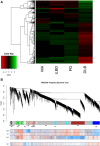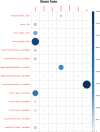Transcriptional network analysis in frontal cortex in Lewy body diseases with focus on dementia with Lewy bodies
- PMID: 28321951
- PMCID: PMC8028609
- DOI: 10.1111/bpa.12511
Transcriptional network analysis in frontal cortex in Lewy body diseases with focus on dementia with Lewy bodies
Abstract
The present study investigates global transcriptional changes in frontal cortex area 8 in incidental Lewy Body disease (iLBD), Parkinson disease (PD) and Dementia with Lewy bodies (DLB). We identified different coexpressed gene sets associated with disease stages, and gene ontology categories enriched in gene modules and differentially expressed genes including modules or gene clusters correlated to iLBD comprising upregulated dynein genes and taste receptors, and downregulated innate inflammation. Focusing on DLB, we found modules with genes significantly enriched in functions related to RNA and DNA production, mitochondria and energy metabolism, purine metabolism, chaperone and protein folding system and synapses and neurotransmission (particularly the GABAergic system). The expression of more than fifty selected genes was assessed with real time quantitative polymerase chain reaction. Our findings provide, for the first time, evidence of molecular cortical alterations in iLBD and involvement of several key metabolic pathways and gene hubs in DLB which may underlie cognitive impairment and dementia.
Keywords: GABA; Lewy body diseases; axonema; cerebral cortex; chaperones; dementia with Lewy bodies; dynein; mitochondria; neurotransmission; purine metabolism; synapses; taste receptors; transcriptome.
© 2017 International Society of Neuropathology.
Figures




References
-
- Alafuzoff I, Ince PG, Arzberger T, Al‐Sarraj S, Bell J, Bodi I et al (2009) Staging/typing of Lewy body related alphasynuclein pathology: a study of the BrainNet Europe Consortium. Acta Neuropathol 117:635–652. - PubMed
-
- Baek JH, Whitfield D, Howlett D, Francis P, Bereczki E, Ballard C et al (2016) Unfolded protein response is activated in Lewy body dementias. Neuropathol Appl Neurobiol 42:352–365. - PubMed
-
- Barrachina M, Castaño E, Ferrer I (2006) TaqMan PCR assay in the control of RNA normalization in human post‐mortem brain tissue. Neurochem Int 49:276–284. - PubMed
Publication types
MeSH terms
LinkOut - more resources
Full Text Sources
Other Literature Sources
Medical

